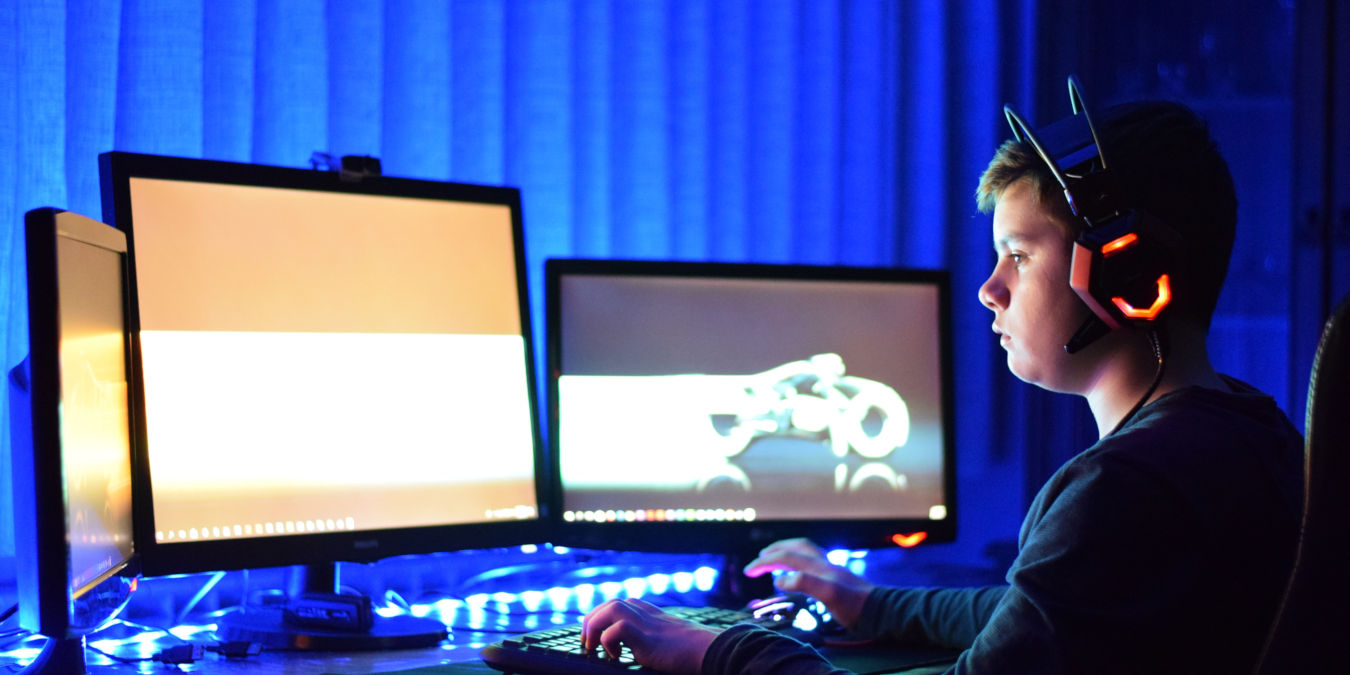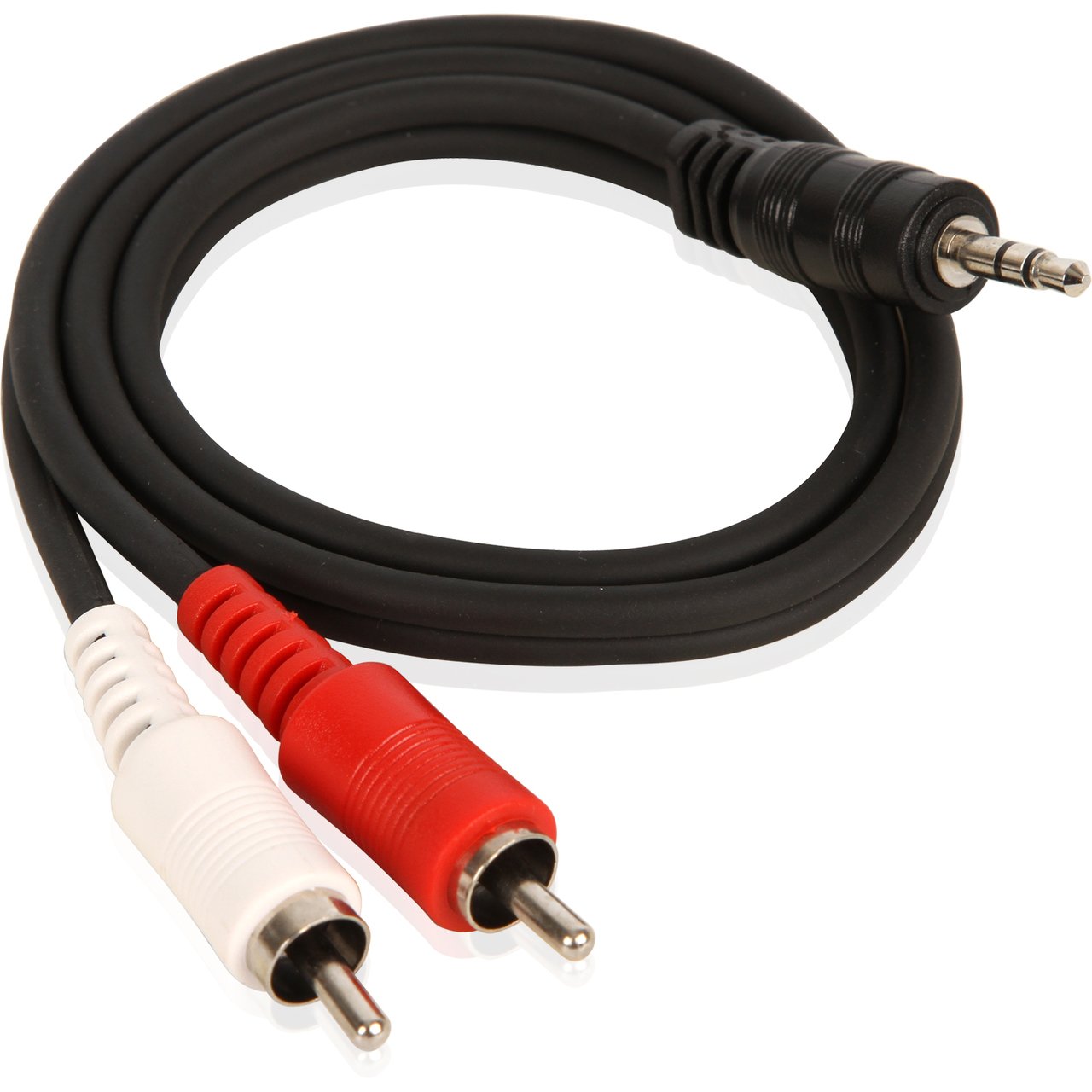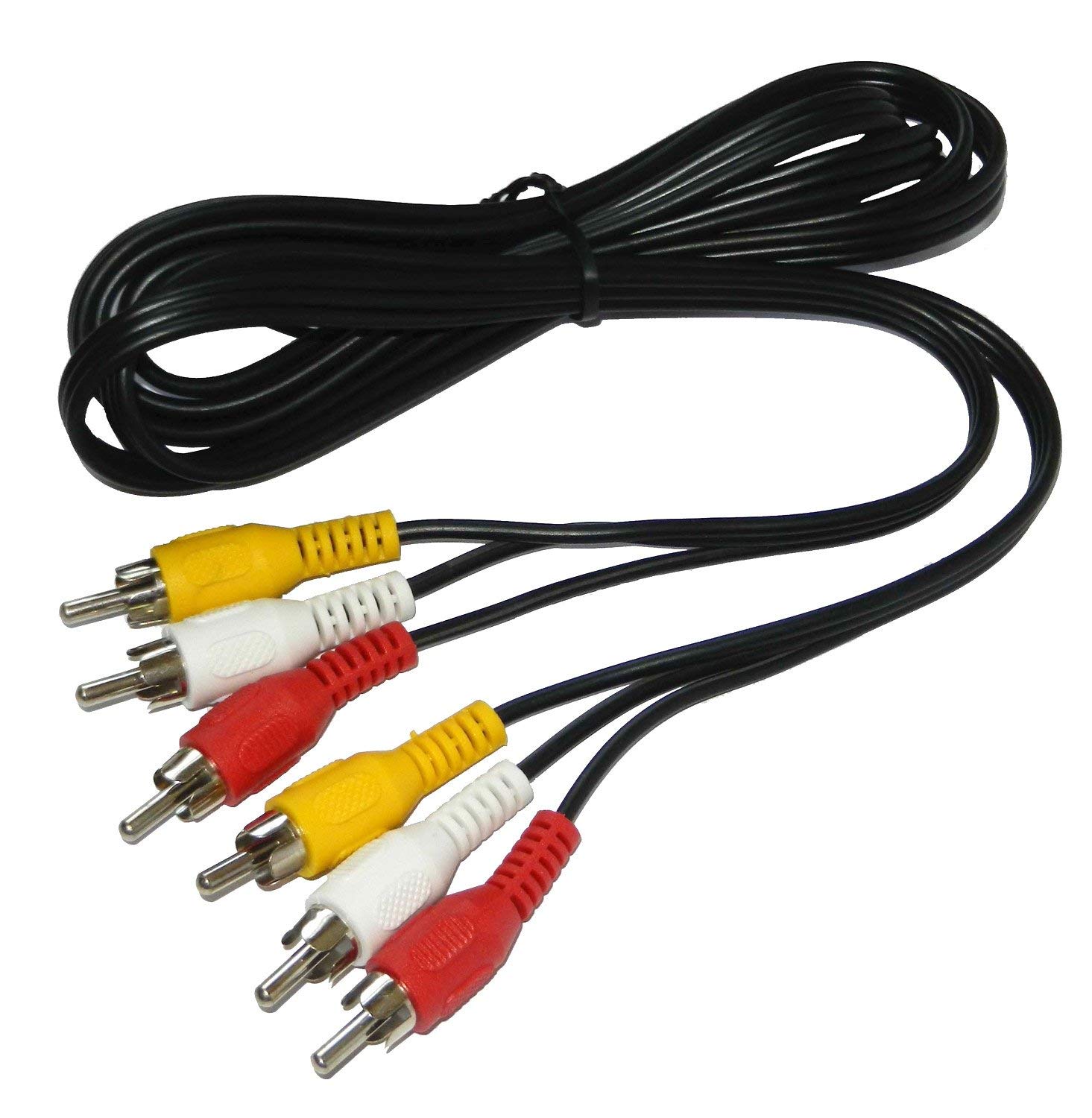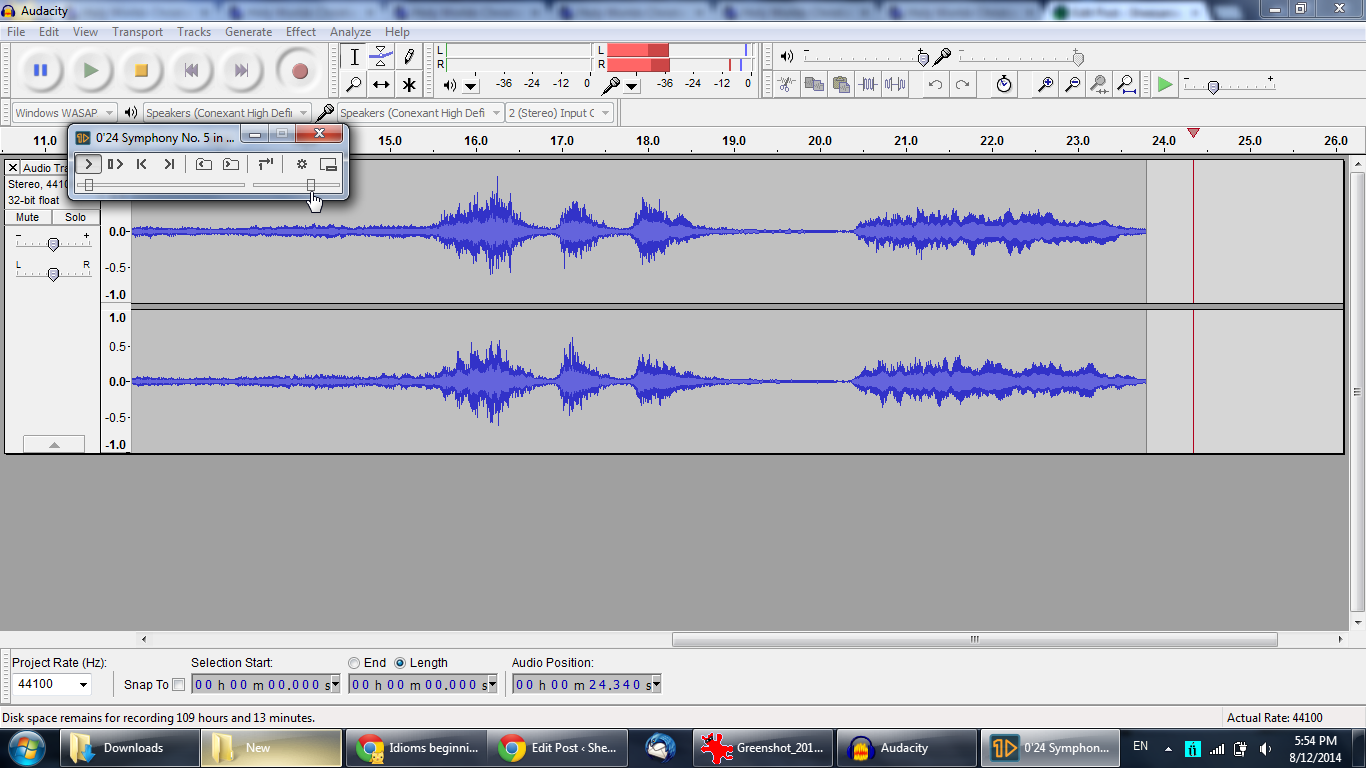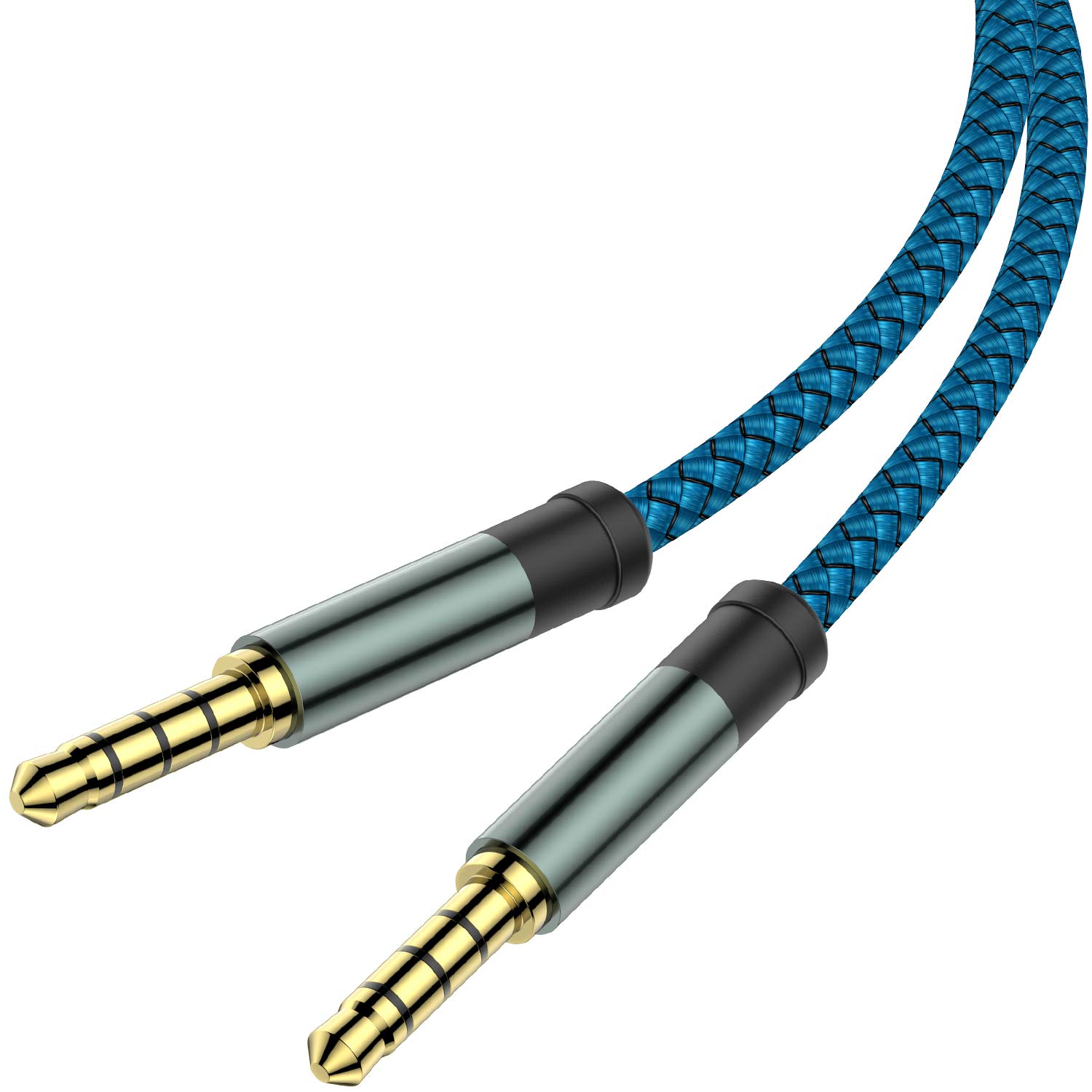Home>Production & Technology>Audio Cable>Where To Use Shielded Audio Cable
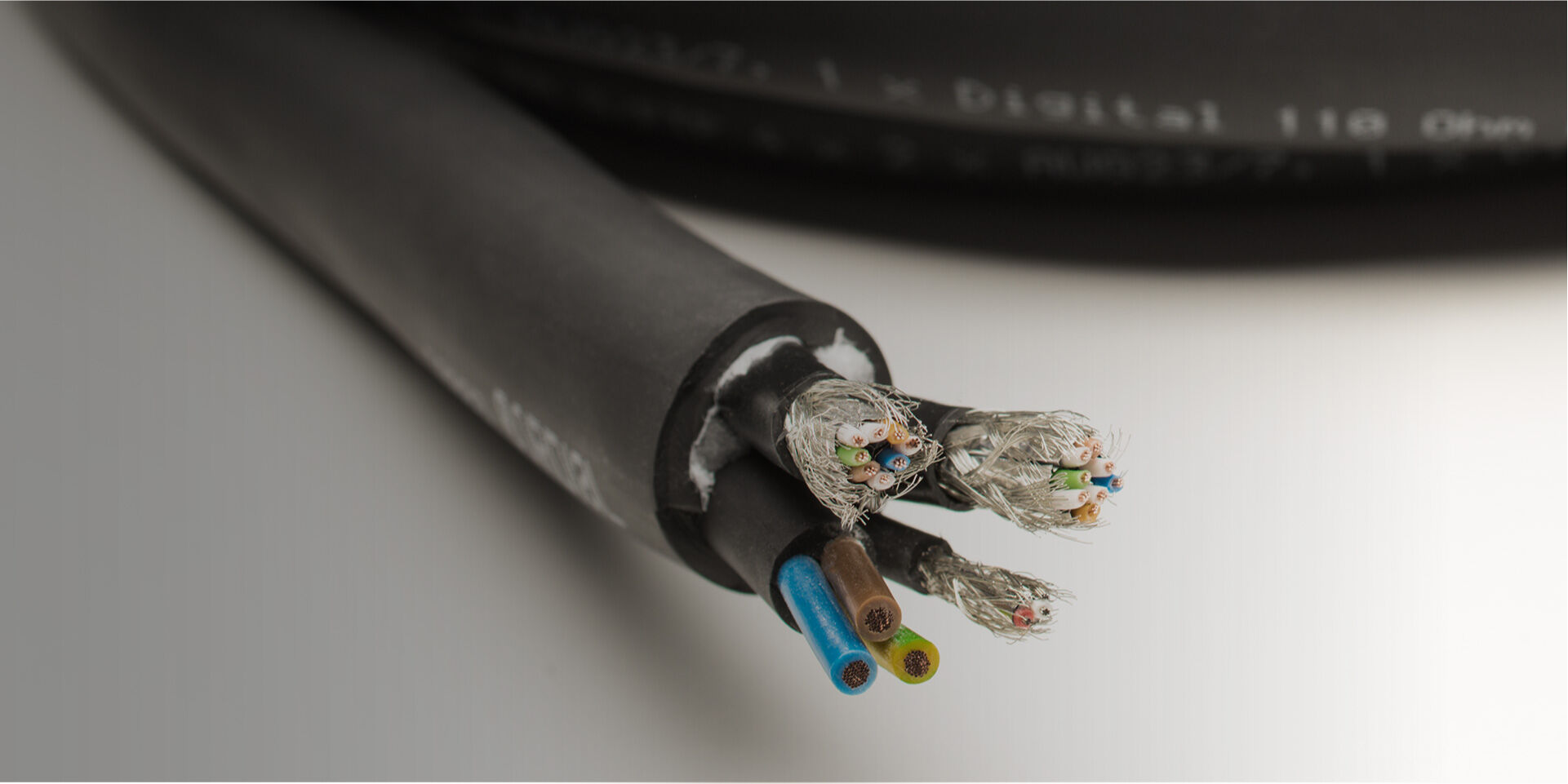

Audio Cable
Where To Use Shielded Audio Cable
Modified: January 22, 2024
Looking for the best places to use shielded audio cable? Discover where to optimize your audio connections with high-quality shielded cables for improved sound quality and reduced interference.
(Many of the links in this article redirect to a specific reviewed product. Your purchase of these products through affiliate links helps to generate commission for AudioLover.com, at no extra cost. Learn more)
Table of Contents
- Introduction
- What is shielded audio cable?
- Why is shielded audio cable important?
- Applications of shielded audio cable
- Studio environments
- Live sound events
- Broadcast stations
- Home theaters
- Conference rooms
- Recording studios
- Pro audio installations
- Factors to consider when choosing shielded audio cable
- Conclusion
Introduction
Audio cables are an essential component in any sound system setup, whether it’s for professional audio production in recording studios or for personal entertainment in home theaters. Within the realm of audio cables, shielded audio cable plays a critical role in ensuring the highest quality audio signal transmission.
Shielded audio cables, as the name suggests, are designed with an added layer of shielding to protect the audio signal from electromagnetic interference (EMI) and radio frequency interference (RFI) that can degrade the quality of the audio signal. This shielding is typically made of a conductive material, such as copper or aluminum, and is wrapped around the inner conductor of the cable.
So why is shielded audio cable important? The answer lies in the fact that EMI and RFI are prevalent in our modern-day environment, with electronic devices and power cables emitting electromagnetic radiation that can potentially interfere with audio signals. Shielded audio cable acts as a barrier, preventing these external interferences from affecting the audio signal and thus ensuring a clean and undistorted sound output.
In this article, we will explore the various applications where shielded audio cable is indispensable. Whether you are a sound engineer setting up a recording studio or a homeowner creating a stunning home theater experience, understanding where and why to use shielded audio cable is crucial for achieving optimal audio fidelity.
What is shielded audio cable?
Shielded audio cable is a type of audio cable that is specifically designed to minimize electromagnetic interference (EMI) and radio frequency interference (RFI) that can degrade the quality of audio signals. It consists of multiple components, each serving a specific purpose to ensure optimal audio transmission.
At the core of shielded audio cable is the conductor, which is responsible for carrying the audio signal. The conductor is usually made of copper or sometimes silver, as these metals have excellent conductivity properties. The size and gauge of the conductor can vary depending on the application and desired signal strength.
Surrounding the conductor is the insulation layer, which acts as a protective barrier and prevents signal leakage or interference from neighboring conductors or external sources. The insulation material used is typically a high-quality polymer, such as polyethylene or polyvinyl chloride (PVC), which helps to maintain the integrity of the audio signal.
The distinguishing feature of shielded audio cable is the additional layer of shielding. This shielding is typically made of a conductive material, such as copper or aluminum, and serves to reduce the impact of EMI and RFI. The shielding is wrapped around the insulated conductor, forming a barrier that blocks out external electromagnetic radiation.
Furthermore, shielded audio cables often feature a metal foil layer, known as a foil shield, which provides additional protection against interference. The foil shield is typically made of aluminum and is applied around the insulated conductor before the outer shielding is added.
In some cases, shielded audio cables may also include a drain wire, which is a separate wire that runs alongside the conductor and is connected to the shielding. The drain wire helps to dissipate any residual interference that the shielding may not completely block, further enhancing the cable’s performance.
The combination of the conductor, insulation layer, shielding, foil shield, and sometimes a drain wire, make shielded audio cable highly effective in minimizing interference and maintaining the integrity of audio signals. This ensures that the audio quality remains clear, resulting in a superior listening or recording experience.
Why is shielded audio cable important?
Shielded audio cable plays a crucial role in maintaining the integrity and quality of audio signals. Here are some key reasons why shielded audio cable is essential:
- Protection against electromagnetic interference (EMI) and radio frequency interference (RFI): In today’s modern world, we are surrounded by electronic devices and power cables that emit electromagnetic radiation. This radiation can interfere with audio signals, leading to distorted sound and decreased audio quality. Shielded audio cable acts as a barrier, preventing external interferences from affecting the audio signal, and ensuring clean, uninterrupted sound reproduction.
- Reduction of signal noise: Electrical devices and power cables generate noise, which can be picked up by audio cables. Shielded audio cable helps to minimize this noise by isolating the audio signal from external sources. This results in improved signal-to-noise ratio, allowing for clearer audio reproduction.
- Enhancement of audio fidelity: Shielded audio cable preserves the integrity of the audio signal, delivering high-fidelity sound reproduction. By preventing interference and minimizing signal loss, shielded audio cable ensures that the true essence of the audio is preserved without any distortions or compromises.
- Higher signal transmission quality: Shielded audio cable is designed to maintain consistent signal strength throughout the cable length. This means that the audio signal experiences minimal loss as it travels from the source to the destination, resulting in a stronger and more reliable signal transmission.
- Compatibility with sensitive equipment: Certain audio devices and equipment, such as microphones, mixers, and preamps, are highly sensitive and can be susceptible to interference. Shielded audio cable provides the necessary protection and shielding to ensure that these sensitive devices receive clean, interference-free signals.
Whether you are setting up a recording studio, a live sound event, or a home theater system, investing in high-quality shielded audio cables is essential. They provide a reliable and consistent audio signal, free from interference and signal loss, resulting in a superior audio experience. When it comes to audio quality, shielded audio cable is an indispensable component that should not be overlooked.
Applications of shielded audio cable
Shielded audio cable finds a wide range of applications in various industries where high-quality audio transmission is critical. Let’s explore some of the key areas where shielded audio cable is commonly used:
- Studio environments: Shielded audio cable is a staple in professional recording studios, where capturing pristine audio quality is paramount. From connecting microphones and instruments to audio interfaces and studio monitors, shielded audio cables ensure minimal interference and signal degradation, allowing for the most accurate and faithful audio recording and playback.
- Live sound events: Shielded audio cables are essential in live sound applications, such as concerts, music festivals, and theatrical performances. They are used to connect microphones, instruments, and audio equipment on stage, ensuring reliable and interference-free sound transmission to the main sound system.
- Broadcast stations: Radio and television broadcast stations rely on shielded audio cables to maintain superior sound quality during live broadcasts. Whether it’s for connecting microphones, audio consoles, or transmission equipment, shielded audio cables help deliver clear and artifact-free audio signals to millions of listeners and viewers.
- Home theaters: Shielded audio cable is a must-have for creating immersive audio experiences in home theaters. From connecting AV receivers and speakers to subwoofers and surround sound systems, shielded audio cables ensure accurate and distortion-free audio reproduction, enhancing the overall cinematic experience.
- Conference rooms: Shielded audio cables play a vital role in conference rooms where audio quality during meetings and presentations is crucial. They are used to connect microphones, speakers, and audio conferencing systems, ensuring clear and intelligible sound for effective communication.
- Recording studios: Shielded audio cables are integral to the workflow of recording studios, where professional audio production takes place. They are used for connecting audio interfaces, studio monitors, outboard gear, and other audio equipment, ensuring accurate signal transmission without any unwanted noise or interference.
- Pro audio installations: In large-scale audio installations such as stadiums, concert halls, and auditoriums, shielded audio cables are essential for delivering high-quality sound to a large audience. They are used to connect speakers, amplifiers, mixers, and other audio equipment, ensuring optimal audio performance and minimal signal loss.
These are just a few examples of the many applications where shielded audio cables are crucial. In any scenario where audio quality and integrity are paramount, shielded audio cable serves as the backbone, ensuring reliable and interference-free audio signal transmission.
Studio environments
Studio environments demand the highest level of audio quality and precision, making shielded audio cable an essential component in the setup. Whether it’s a professional recording studio, a home studio, or a project studio, shielded audio cables play a crucial role in maintaining the integrity of audio signals.
In a recording studio, shielded audio cables are used to connect a wide range of equipment, including microphones, instruments, audio interfaces, studio monitors, and outboard gear. These cables ensure that the audio signal remains unaffected by external interference, allowing for accurate and faithful recording and monitoring.
One of the primary applications of shielded audio cable in studio environments is for microphone connections. Microphones are highly sensitive devices that can pick up even the smallest electrical interference. Shielded audio cables help minimize this interference, ensuring that the captured audio is clean and free from unwanted noise or hum.
Additionally, shielded audio cables are used for connecting audio interfaces, which serve as the bridge between microphones, instruments, and the digital recording system. These cables ensure the accurate transmission of the audio signal from the interface to the computer or recording device, without degradation or distortion.
Another crucial application of shielded audio cable in studio environments is for connecting studio monitors or speakers. Shielding helps to eliminate interference that can affect the playback of recorded audio, ensuring that the mix is reproduced accurately and transparently.
Furthermore, shielded audio cables are used to connect outboard gear, such as compressors, equalizers, and effects processors. These devices play a crucial role in shaping the sound during the mixing and mastering process. Shielded cables ensure that the audio signal remains clean and unaffected by any external electromagnetic interference, allowing engineers to make precise adjustments to the audio.
Overall, in studio environments, shielded audio cables are essential for maintaining audio integrity, minimizing interference, and achieving optimal sound quality. They are the backbone of any recording setup, ensuring that every component in the signal chain works together flawlessly to deliver professional-grade audio recordings.
Live sound events
When it comes to live sound events, such as concerts, music festivals, and theatrical performances, shielded audio cables are indispensable for delivering high-quality and reliable sound reinforcement. These cables are designed to withstand the rigors of live performances, ensuring that the audio signals remain clear and free from interference.
In live sound applications, shielded audio cables are used to connect microphones, instruments, and audio equipment on stage to the main sound system. Microphones, in particular, are critical components that capture the sound of performers and transmit it to the console or mixing desk.
Shielded audio cables play a crucial role in this process by minimizing interference from external sources, such as stage lighting, power cables, and other electronic devices. This ensures that the audio signal from the microphone remains clean and unaffected, allowing sound engineers to accurately mix and amplify the sound for the audience.
Additionally, shielded audio cables are used for instrument connections on stage, including electric guitars, keyboards, and other electronic instruments. These cables prevent unwanted noise and interference from affecting the audio signal, ensuring that the instrument’s sound is transmitted accurately and faithfully.
Live sound events often involve the use of audio snakes, which are multi-channel cables that consolidate multiple audio channels into a single cable for easy connection and organization. Shielded audio snakes are particularly useful in this context, as they ensure clean signal transmission and effective noise rejection over long cable runs.
Moreover, shielded audio cables are crucial for connecting the main sound system to a front-of-house (FOH) mixing console or a monitor console. These cables carry the audio signals from the stage to the mixing desk, where sound engineers can further manipulate and control the audio before it is amplified or sent to the monitors on stage.
Whether it’s a small venue or a large outdoor festival, live sound events rely on shielded audio cables to deliver pristine sound quality to the audience. These cables help eliminate unwanted noise, interference, and signal degradation, allowing for a seamless and immersive live sound experience.
Broadcast stations
Broadcast stations, including radio and television stations, depend on shielded audio cables to ensure the highest quality audio transmission during live broadcasts. These cables play a crucial role in maintaining clear and reliable audio signals, enabling broadcasters to deliver exceptional sound to millions of listeners and viewers.
In broadcast stations, shielded audio cables are used for a variety of purposes, starting with microphone connections. Microphones are the primary means of capturing audio in broadcasting, and shielded cables help prevent electromagnetic interference (EMI) from affecting the microphone signal. This ensures that the audio captured by the microphone remains clean and intelligible.
Furthermore, shielded audio cables are used for connecting audio console inputs and outputs in broadcast stations. These consoles allow sound engineers and broadcasters to control and mix various audio sources before they are transmitted to the audience. Shielded cables help maintain the integrity of the audio signals as they pass through the console, reducing the risk of interference and signal degradation.
In radio broadcasting, where multiple studio spaces and control rooms are often involved, shielded audio cables are used to connect different areas within the station. This includes routing audio signals from studio to control rooms, as well as connecting various audio devices and equipment throughout the broadcast facility.
Television broadcast stations also heavily rely on shielded audio cables for transmitting audio from on-set microphones, such as lavalier microphones or boom microphones. These cables ensure that the audio captured by the microphones is delivered without any interference or noise to the broadcast control room.
Additionally, shielded audio cables are crucial in connecting audio monitoring systems in broadcast stations. These systems allow sound engineers and broadcasters to monitor and evaluate the audio quality before it is broadcasted. Shielded cables ensure accuracy in signal transmission, enabling precise monitoring for optimal sound quality.
Overall, shielded audio cables are essential components in broadcast stations, ensuring reliable and interference-free audio transmission. By minimizing EMI and maintaining signal integrity, these cables play a vital role in delivering high-quality audio to audiences worldwide, ensuring a seamless and enjoyable broadcasting experience.
Home theaters
Home theaters provide a cinematic audiovisual experience within the comfort of your own home. To achieve immersive and high-quality sound, shielded audio cables are a crucial element in connecting various components of a home theater system.
Shielded audio cables play a significant role in delivering optimal audio performance in home theaters. They are used to connect audio/video receivers (AVRs), speakers, subwoofers, and other audio devices to ensure the accurate transmission of the audio signal.
One of the primary applications of shielded audio cables in home theaters is connecting the speakers to the AV receiver. These cables carry the audio signals from the receiver to the speakers, ensuring that the sound is reproduced accurately and faithfully. Shielded cables minimize the risk of interference, delivering clear and distortion-free audio for a truly immersive listening experience.
Moreover, shielded audio cables are utilized in connecting the subwoofer to the AV receiver. Subwoofers are responsible for producing deep bass frequencies, enhancing the overall impact and depth of the audio. Shielded cables ensure that the low-frequency signals are transmitted without any interference or loss, allowing the subwoofer to deliver powerful and impactful bass performance.
In addition to speaker connections, shielded audio cables are used for connecting audio sources such as Blu-ray players, game consoles, and media streaming devices to the AV receiver. These cables enable the transfer of audio signals from the source devices to the receiver, ensuring accurate and high-quality sound reproduction.
Shielded audio cables are also ideal for home theater installations that involve in-wall or in-ceiling speakers. These cables are designed to meet the requirements for in-wall installations, providing a reliable and interference-free signal transmission while also adhering to safety and building code standards.
Furthermore, shielded audio cables help enhance the overall audio fidelity by minimizing electromagnetic interference (EMI) and radio frequency interference (RFI) from nearby electronic devices, power cables, and other external sources. This ensures that the audio signals remain clean and unaffected, allowing for a more immersive and enjoyable home theater experience.
Whether you’re setting up a dedicated home theater room or integrating a surround sound system into your living space, using shielded audio cables is essential for achieving high-quality audio reproduction. By ensuring reliable signal transmission and minimizing interference, these cables contribute to creating a truly captivating and cinematic audio experience in your home theater.
Conference rooms
Conference rooms are essential spaces for collaboration, presentations, and effective communication. In order to facilitate clear and uninterrupted audio during meetings, shielded audio cables are integral components of conference room setups.
Shielded audio cables play a critical role in connecting various audio devices and equipment within a conference room. These cables ensure reliable signal transmission, minimizing interference, and delivering high-quality audio for effective communication.
One of the primary applications of shielded audio cables in conference rooms is for connecting microphones. Whether it’s handheld microphones or installed podium microphones, shielded cables help maintain the integrity of the microphone signals by reducing electromagnetic interference (EMI) and radio frequency interference (RFI). This ensures that voices are captured accurately and without any unwanted noise or distortion.
Additionally, shielded audio cables are used for connecting speakers or audio amplifiers in conference rooms. These cables carry the audio signals from the audio source, such as a computer or multimedia device, to the speakers, ensuring clear and intelligible sound for presentations, video conferences, and multimedia playback.
Moreover, shielded audio cables are employed in connecting audio conferencing systems in conference rooms. These systems incorporate microphone arrays and speakers to facilitate clear and natural audio for remote participants during conference calls. Shielded cables ensure that the audio signals are transmitted without interference, ensuring effective communication and collaboration.
Furthermore, shielded audio cables are utilized for connecting audio mixers or audio interfaces in conference rooms. These devices allow for better control over audio levels, equalization, and the integration of additional sources such as wireless microphones or audio playback devices. Shielded cables maintain the integrity of the audio signals, allowing for precise adjustments and optimal audio quality.
Shielded audio cables are essential in conference rooms as they provide reliable and interference-free audio transmission. By minimizing EMI and RFI, these cables ensure clear and intelligible sound, enabling effective communication, collaboration, and presentations. Whether it’s for small meeting rooms or large conference venues, shielded audio cables contribute to an efficient and successful conference room experience.
Recording studios
Recording studios are the birthplace of professional audio production, where every detail of sound is meticulously captured and crafted. Shielded audio cables play a vital role in maintaining pristine audio quality, making them an essential component in recording studio environments.
In recording studios, shielded audio cables are used extensively to connect various equipment and devices, ensuring accurate and interference-free signal transmission throughout the recording process.
One of the primary applications of shielded audio cables in recording studios is for microphone connections. Microphones are the primary tools used to capture sound, and shielded cables help minimize electromagnetic interference (EMI) and radio frequency interference (RFI) that can degrade the audio signal. By using shielded cables, recording engineers can achieve clean and detailed recordings with minimal noise and interference.
Shielded audio cables are also used for connecting studio monitors, which are critical for accurate playback and mixing. These cables ensure that the audio signals from the recording system are faithfully reproduced by the monitors, allowing engineers to make precise adjustments to achieve the desired sound.
Additionally, shielded audio cables are employed in connecting outboard gear, such as equalizers, compressors, and effects processors. These devices shape and enhance the audio during the mixing and mastering stages. Shielded cables help maintain the integrity of the audio signal as it passes through the gear, ensuring purity and transparency in the final sound.
Furthermore, shielded audio cables play a key role in connecting audio interfaces, which serve as the bridge between the analog and digital domains. These cables carry the audio signals from microphones, instruments, and other gear to the audio interface, ensuring accurate conversion and transmission of the audio data.
Moreover, shielded audio cables are essential when connecting external instruments, such as synthesizers or drum machines, to the recording system. These cables ensure reliable signal transmission and protect against interference that can affect the precision and clarity of the recorded audio.
Overall, shielded audio cables are vital components in recording studios, ensuring that the audio signals remain clean, accurate, and free from interference. By incorporating shielded cables throughout the signal chain, recording engineers can capture and reproduce audio with exceptional clarity and fidelity, allowing for professional-grade recordings and productions.
Pro audio installations
Pro audio installations refer to large-scale audio setups found in venues such as stadiums, concert halls, auditoriums, and performance spaces. These installations involve complex audio systems, and shielded audio cables play a fundamental role in ensuring optimal sound quality and reliable signal transmission.
In pro audio installations, shielded audio cables are used extensively to connect various components, including amplifiers, speakers, mixers, signal processors, and audio playback devices. These cables are designed to withstand the demands of professional environments, and they provide effective shielding against electromagnetic interference (EMI) and radio frequency interference (RFI).
One of the key applications of shielded audio cables in pro audio installations is speaker connections. These cables are used to transmit the audio signal from the amplifier to the speakers, ensuring clear sound reproduction over long distances. Shielded cables help minimize interference, resulting in improved clarity and fidelity of the sound delivered to the audience.
Furthermore, shielded audio cables are crucial for connecting audio sources, such as mixing consoles or playback devices, to the main sound system. These cables ensure accurate transmission of audio signals without compromise, allowing for precise control and manipulation of the sound during live performances or events.
In pro audio installations, shielded audio cables are also utilized for connecting stage boxes or audio snakes. These multi-channel cables consolidate multiple audio inputs and outputs into a single cable, streamlining connections and minimizing cable clutter. Shielded audio snakes ensure reliable signal transmission and noise rejection in large-scale audio setups.
Moreover, shielded audio cables are used for integrating wireless audio systems in pro audio installations. Wireless microphones, in-ear monitors, and other wireless audio devices transmit signals without the use of physical cables. However, shielded audio cables are still essential for connecting the receiver units and ensuring optimal signal quality.
Additionally, shielded audio cables are employed in connecting rack-mounted equipment, such as signal processors, equalizers, and power amplifiers. These cables provide clean and interference-free signal flow, allowing for seamless integration and precise control over the audio systems.
In summary, shielded audio cables are vital components in pro audio installations, guaranteeing that the audio signals remain clean and undisturbed. By utilizing shielded cables, audio professionals can achieve exceptional sound quality, minimize interference, and deliver immersive and unforgettable audio experiences in large-scale venues and performance spaces.
Factors to consider when choosing shielded audio cable
When selecting shielded audio cable for your specific audio application, it’s important to consider several factors to ensure optimal performance and compatibility. Here are some key factors to keep in mind:
- Shielding effectiveness: The primary purpose of shielded audio cable is to protect the audio signal from electromagnetic interference (EMI) and radio frequency interference (RFI). It’s essential to choose a cable with high shielding effectiveness, typically achieved through multiple layers of shielding such as foil shielding and braided shielding.
- Cable construction: Consider the construction of the cable, including the conductor material, insulation, and shielding layers. Copper conductors are commonly used for their excellent conductivity, while insulation materials like polyethylene or PVC provide durability and insulation properties. The type and thickness of the shielding layers can also impact the cable’s performance.
- Cable diameter and flexibility: The diameter and flexibility of the cable can affect ease of installation and cable management. Thicker cables may be more durable and offer better protection against interference but could be less flexible and harder to work with in tight spaces.
- Cable length: Consider the length requirements for your specific application. It’s important to choose a cable that offers sufficient length without signal degradation. Longer cable runs may require thicker gauge cables to minimize signal loss over distance.
- Connectors: Pay attention to the type and quality of connectors used on the cable. Ensure that they are compatible with your audio devices and provide a secure and reliable connection. Look for connectors with proper shielding and strain relief to prevent signal loss and physical damage to the cable.
- Application-specific considerations: Different audio applications may have specific requirements. For example, in a recording studio, low noise and high fidelity may be crucial, while in a live sound environment, durability and flexibility may take priority. Consider the specific demands of your audio setup and choose a cable suitable for that environment.
- Budget: Like with any purchase, consider your budget. While it’s important not to compromise on quality, there are often options available at different price points. Research and compare different brands and models to find a balance between performance and affordability.
By considering these factors when choosing shielded audio cable, you can ensure that you select the right cable for your specific audio needs. Whether it’s for professional audio production, live sound events, or personal entertainment, a well-chosen shielded audio cable will help deliver consistent, interference-free, and high-quality audio performance.
Conclusion
Shielded audio cables are an essential component in audio systems, providing reliable and interference-free signal transmission. Whether used in recording studios, live sound events, broadcast stations, home theaters, conference rooms, or pro audio installations, these cables play a critical role in maintaining optimal audio quality and fidelity.
The shielding of these cables protects against electromagnetic interference (EMI) and radio frequency interference (RFI), which can degrade audio signals and introduce unwanted noise and distortion. By minimizing these interferences, shielded audio cables ensure clear and uninterrupted audio reproduction, allowing for a more immersive and enjoyable listening experience.
When choosing shielded audio cables, it’s important to consider factors such as shielding effectiveness, cable construction, flexibility, length, connectors, and application-specific requirements. By taking these factors into account, you can select cables that meet the unique demands of your audio setup and provide the highest levels of performance and reliability.
Whether you’re a professional audio engineer, a sound enthusiast, or a homeowner looking to create the perfect home theater experience, investing in high-quality shielded audio cables is essential. These cables ensure that the audio signals remain clean, accurate, and free from interference, resulting in exceptional sound quality.
From capturing crisp vocals in a recording studio to delivering powerful sound in a live concert, shielded audio cables contribute to the success of various audio applications. Their ability to maintain signal integrity and minimize interference makes them indispensable tools for achieving professional-grade audio reproduction.
In conclusion, shielded audio cables are the backbone of audio systems, providing the foundation for clear, reliable, and high-quality sound. By understanding their importance and selecting the right cables for your specific needs, you can ensure that every audio experience is immersive, engaging, and truly exceptional.

